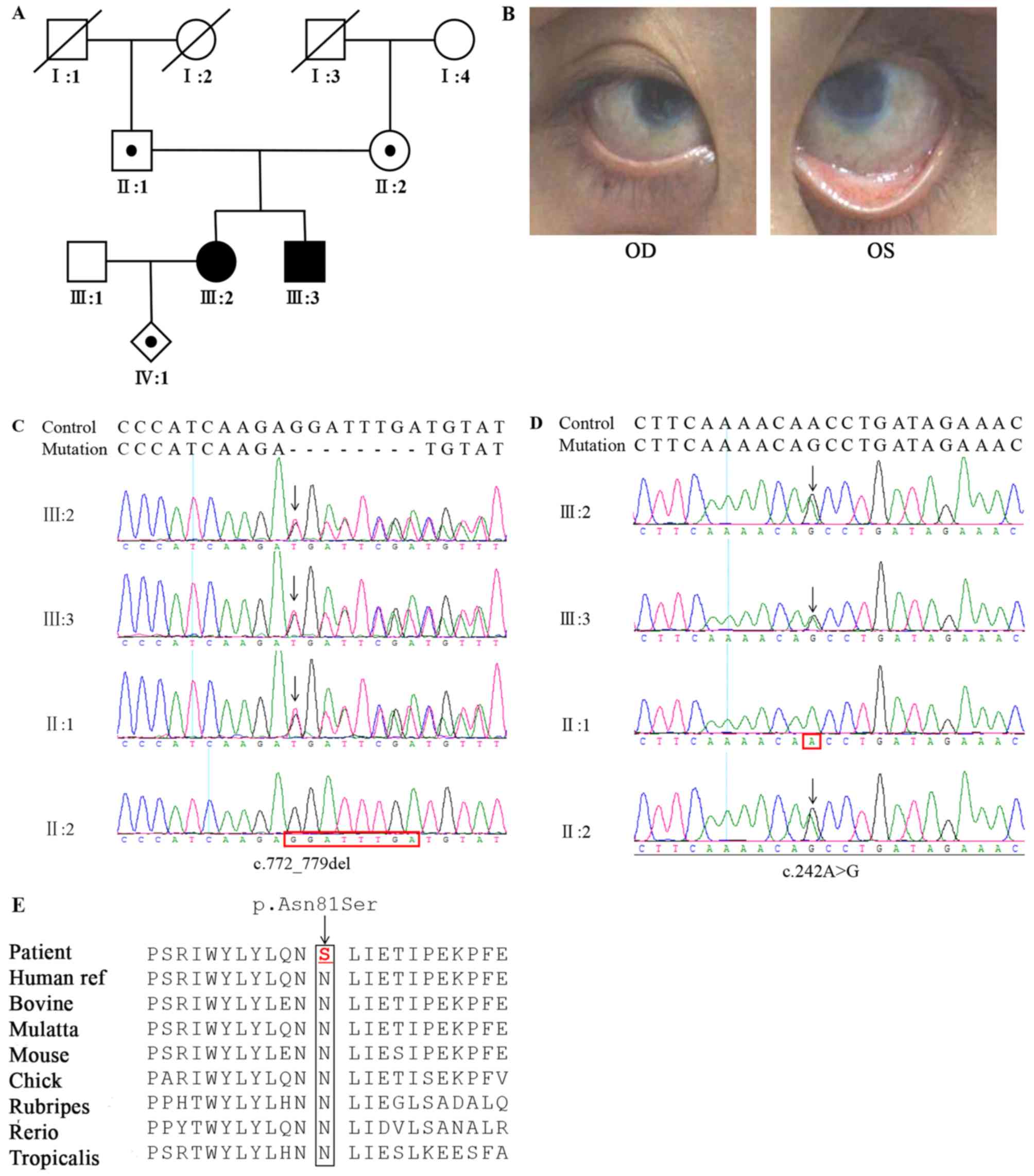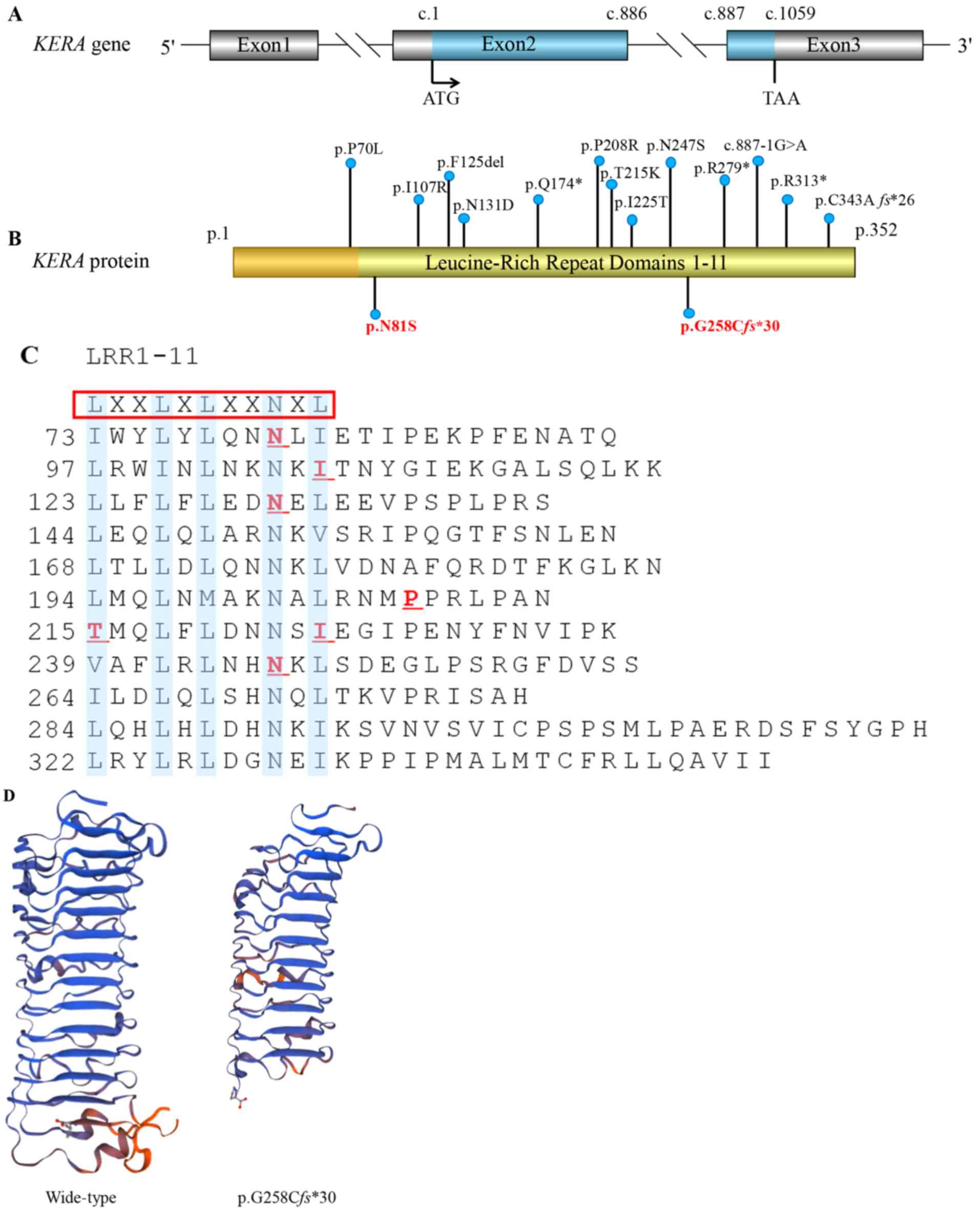|
1
|
Pellegata NS, Dieguez-Lucena JL, Joensuu
T, Lau S, Montgomery KT, Krahe R, Kivelä T, Kucherlapati R, Forsius
H and de la Chapelle A: Mutations in KERA, encoding keratocan,
cause cornea plana. Nat Genet. 25:91–95. 2000. View Article : Google Scholar : PubMed/NCBI
|
|
2
|
Khan AO, Aldahmesh M and Meyer B: Corneal
ectasia and hydrops in a patient with autosomal recessive cornea
plana. Ophthalmic Genet. 27:99–101. 2006. View Article : Google Scholar : PubMed/NCBI
|
|
3
|
Khan AO, Aldahmesh M and Meyer B:
Recessive cornea plana in the Kingdom of Saudi Arabia.
Ophthalmology. 113:1773–1778. 2006. View Article : Google Scholar : PubMed/NCBI
|
|
4
|
Khan AO, Aldahmesh MA, Al-Gehedan S, Meyer
BF and Alkuraya FS: Corneal decompensation in recessive cornea
plana. Ophthalmic Genet. 30:142–145. 2009. View Article : Google Scholar : PubMed/NCBI
|
|
5
|
Tahvanainen E, Forsius H, Kolehmainen J,
Damsten M, Fellman J and de la Chapelle A: The genetics of cornea
plana congenita. J Med Genet. 33:116–119. 1996. View Article : Google Scholar : PubMed/NCBI
|
|
6
|
Lehmann OJ, El-ashry MF, Ebenezer ND,
Ocaka L, Francis PJ, Wilkie SE, Patel RJ, Ficker L, Jordan T, Khaw
PT and Bhattacharya SS: A novel keratocan mutation causing
autosomal recessive cornea plana. Invest Ophthalmol Vis Sci.
42:3118–3122. 2001.PubMed/NCBI
|
|
7
|
Khan AO, Al-Saif A and Kambouris M: A
novel KERA mutation associated with autosomal recessive cornea
plana. Ophthalmic Genet. 25:147–152. 2004. View Article : Google Scholar : PubMed/NCBI
|
|
8
|
Ebenezer ND, Patel CB, Hariprasad SM, Chen
LL, Patel RJ, Hardcastle AJ and Allen RC: Clinical and molecular
characterization of a family with autosomal recessive cornea plana.
Arch Ophthalmol. 123:1248–1253. 2005. View Article : Google Scholar : PubMed/NCBI
|
|
9
|
Khan AO, Aldahmesh M, Al-Saif A and Meyer
B: Pellucid marginal degeneration coexistent with cornea plana in
one member of a family exhibiting a novel KERA mutation. Br J
Ophthalmol. 89:1538–1540. 2005. View Article : Google Scholar : PubMed/NCBI
|
|
10
|
Liskova P, Hysi PG, Williams D, Ainsworth
JR, Shah S, de la Chapelle A, Tuft SJ and Bhattacharya SS: Study of
p.N247S KERA mutation in a British family with cornea plana. Mol
Vis. 13:1339–1347. 2007.PubMed/NCBI
|
|
11
|
AlBakri A and Khan AO: Regarding corneal
decompensation in recessive cornea plana. Ophthalmic Genet.
37:350–351. 2016. View Article : Google Scholar : PubMed/NCBI
|
|
12
|
Tasheva ES, Funderburgh JL, Funderburgh
ML, Corpuz LM and Conrad GW: Structure and sequence of the gene
encoding human keratocan. DNA. 10:67–74. 1999.
|
|
13
|
Kobe B and Deisenhofer J: The leucine-rich
repeat: A versatile binding motif. Trends Biochem Sci. 19:415–421.
1994. View Article : Google Scholar : PubMed/NCBI
|
|
14
|
Kobe B and Deisenhofer J: Proteins with
leucine-rich repeats. Curr Opin Struct Biol. 5:409–416. 1995.
View Article : Google Scholar : PubMed/NCBI
|
|
15
|
Bella J, Hindle KL, McEwan PA and Lovell
SC: The leucine-rich repeat structure. Cell Mol Life Sci.
65:2307–2333. 2008. View Article : Google Scholar : PubMed/NCBI
|
|
16
|
Kao WW and Liu CY: Roles of lumican and
keratocan on corneal transparency. Glycoconj J. 19:275–285. 2002.
View Article : Google Scholar : PubMed/NCBI
|
|
17
|
Liu CY, Shiraishi A, Kao CW, Converse RL,
Funderburgh JL, Corpuz LM, Conrad GW and Kao WW: The cloning of
mouse keratocan cDNA and genomic DNA and the characterization of
its expression during eye development. J Biol Chem.
273:22584–22588. 1998. View Article : Google Scholar : PubMed/NCBI
|
|
18
|
Liu CY, Birk DE, Hassell JR, Kane B and
Kao WW: Keratocan-deficient mice display alterations in corneal
structure. J Biol Chem. 278:21672–21677. 2003. View Article : Google Scholar : PubMed/NCBI
|
|
19
|
Forsius H, Damsten M, Eriksson AW, Fellman
J, Lindh S and Tahvanainen E: Autosomal recessive cornea plana. A
clinical and genetic study of 78 cases in Finland. Acta Ophthalmol
Scand. 76:196–203. 1998. View Article : Google Scholar : PubMed/NCBI
|
|
20
|
Dudakova L, Palos M, Hardcastle AJ and
Liskova P: Corneal endothelial findings in a Czech patient with
compound heterozygous mutations in KERA. Ophthalmic Genet.
35:252–254. 2014. View Article : Google Scholar : PubMed/NCBI
|
|
21
|
Roos L, Bertelsen B, Harris P, Bygum A,
Jensen H, Grønskov K and Tümer Z: Case report: A novel KERA
mutation associated with cornea plana and its predicted effect on
protein function. BMC Med Genet. 16:402015. View Article : Google Scholar : PubMed/NCBI
|
|
22
|
Kumari D, Tiwari A, Choudhury M, Kumar A,
Rao A and Dixit M: A novel KERA mutation in a case of autosomal
recessive cornea plana with primary angle-closure glaucoma. J
Glaucoma. 25:e106–e109. 2016. View Article : Google Scholar : PubMed/NCBI
|
|
23
|
Dudakova L, Vercruyssen JHJ, Balikova I,
Postolache L, Leroy BP, Skalicka P and Liskova P: Analysis of KERA
in four families with cornea plana identifies two novel mutations.
Acta Ophthalmol. 96:e87–e91. 2018. View Article : Google Scholar : PubMed/NCBI
|
|
24
|
Khan AO: Corneal ectasia in a boy with
homozygous KERA mutation. Ophthalmic Genet. 39:141–143. 2018.
View Article : Google Scholar : PubMed/NCBI
|
|
25
|
Chen R, Im H and Snyder M: Whole-exome
enrichment with the Roche nimbleGen SeqCap EZ exome library SR
platform. Cold Spring Harb Protoc. 2015:634–641. 2015. View Article : Google Scholar : PubMed/NCBI
|
|
26
|
Richards S, Aziz N, Bale S, Bick D, Das S,
Gastier-Foster J, Grody WW, Hegde M, Lyon E, Spector E, et al:
Standards and guidelines for the interpretation of sequence
variants: A joint consensus recommendation of the American College
of Medical Genetics and Genomics and the Association for Molecular
Pathology. Genet Med. 17:405–424. 2015. View Article : Google Scholar : PubMed/NCBI
|
|
27
|
Adzhubei IA, Schmidt S, Peshkin L,
Ramensky VE, Gerasimova A, Bork P, Kondrashov AS and Sunyaev SR: A
method and server for predicting damaging missense mutations. Nat
Methods. 7:248–249. 2010. View Article : Google Scholar : PubMed/NCBI
|
|
28
|
Ng PC and Henikoff S: Predicting
deleterious amino acid substitutions. Genome Res. 11:863–874. 2001.
View Article : Google Scholar : PubMed/NCBI
|
|
29
|
Offord V, Coffey TJ and Werling D:
LRRfinder: A web application for the identification of leucine-rich
repeats and an integrative Toll-like receptor database. Dev Comp
Immunol. 34:1035–1041. 2010. View Article : Google Scholar : PubMed/NCBI
|
|
30
|
Arnold K, Bordoli L, Kopp J and Schwede T:
The SWISS-MODEL workspace: A web-based environment for protein
structure homology modelling. Bioinformatics. 22:195–201. 2006.
View Article : Google Scholar : PubMed/NCBI
|
|
31
|
Kobe B and Deisenhofer J: Crystal
structure of porcine ribonuclease inhibitor, a protein with
leucine-rich repeats. Nature. 366:751–756. 1993. View Article : Google Scholar : PubMed/NCBI
|
















